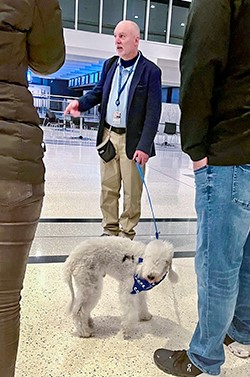 TSA Manager Lori Avizof discusses security screening during a Fear of Flying seminar at Lehigh Valley International Airport. (Photo by Lisa Farbstein)
TSA Manager Lori Avizof discusses security screening during a Fear of Flying seminar at Lehigh Valley International Airport. (Photo by Lisa Farbstein)
A handful of people trickled into a conference room at Lehigh Valley International Airport in Pennsylvania, each somewhat hesitant to even step foot in the terminal. They came to attend a free airport-run seminar for people who have a fear of flying.
TSA Manager Lori Avizof, who spoke at the seminar, said she and the transportation security officers (TSOs) she works with pay special attention to trying to help nervous passengers become more relaxed.
“I believe most of our officers are very in tune with their surroundings. A huge part of an effective TSO is observing their passengers,” Avizof said. “Our TSOs always try to help when they observe a passenger is upset or uncomfortable with the screening process or with flying in general. We try to make the passenger comfortable and put them at ease. We truly want our passengers to have a great experience at our airport.”
The 2 1/2-hour seminar featured a three-pronged approach. A licensed clinical social worker discussed strategies to help cope with anxiety. Then Avizof went over what to be aware of when going through a TSA security checkpoint. Finally, an airline pilot talked about what to expect when boarding and taking a flight.
Some attendees said they wanted to overcome their anxiety about flying to be able to attend their children’s out-of-town sporting events. Another talked about how she had studied abroad in college with no issues, but later became anxious about flying. A woman described flight-related anxiety she experienced after she had children. One participant told the group claustrophobia contributed to her nervousness.

The social worker kicked off the session by sharing tools and tips the attendees could use to comfort themselves when planning for and taking a flight. She pointed to possible triggers of their anxiety such as being afraid of danger, fear of heights, or claustrophobia. She said about 40% of people have some sort of anxiety about flying, but the level of their anxiety greatly varies.
The social worker shared relaxation techniques from head-to-toe to help participants train their bodies to relax. She encouraged them to practice the techniques ahead of their trips. She described several breathing exercises, advising the group to concentrate on what made them feel happy and suggested they be mindful of what they were thinking about to calm their minds before and during a flight. She also walked the group through a meditation exercise to help lower anxiety.
Avizof, who has worked for TSA for 20 years and previously was a flight attendant, explained the steps of going through the checkpoint screening process. She advised the group to arrive two hours before their flight and pack 3-1-1 bags in advance (The 3-1-1 rule says you can carry liquids on board if they're in containers of 3.4 ounces or less, they must fit in one quart-sized bag, and each passenger can only have one bag). Avizof also recommended they wear comfortable clothes.
“TSA Cares is a wonderful resource that you can call in advance of your flight in case you have questions or if you think you might require some additional assistance when you get to the checkpoint,” she said, explaining that passenger support specialists might be able to help worried travelers.
“It’s an entirely different experience to fly out of a smaller airport compared to a larger one,” she said. Avizof noted the atmosphere in smaller airports tends to be somewhat calmer than the congestion and hustle and bustle of larger terminals.
Avizof also encouraged the group to download the MyTSA app as well as some of the airline apps so they could see that their flights have previously taken off and landed safely. “You can see when your plane has departed to arrive at your airport, and you can track your flights,” she said.
The group had the opportunity to go through the airport’s fully-staffed checkpoint so they could practice giving their IDs to the TSA officer at the travel document check station, experience the divesting process, and go through the walk-through metal detector or advanced imaging technology machines. Then, it was time to regroup before heading to a gate where they boarded a plane that was parked for the night.
The pilot allowed the participants to explore the 150-seat airplane and get a sense of whether they preferred a window, aisle or middle seat. Prospective passengers had the opportunity to peek into the restrooms, galley and cockpit. The pilot explained a variety of the airplane noises that passengers might hear, and she also reviewed the safety briefing.
The future travelers also spent a few minutes getting introduced to an emotional support dog that often visits the airport.
“It’s a really valuable session for the participants,” said Avizof, who has been a regular presenter during the airport’s fear of flying seminars. “I hope it helps answer some of their questions so they are more comfortable when they do decide to fly.”
By Lisa Farbstein, TSA Strategic Communications & Public Affairs

